SEO
Cannibalization’s Good Twin (SEO Study)

At Ahrefs.com we’ve got 9.7k cases of multiple rankings. It’s when a site ranks for a keyword with more than one page.
Now, classic SEO theory says that if you rank with more than one page for a keyword, it’s a cannibalization issue, and you should fix it.
But when I spent a day carefully reviewing a sample of 80 keywords with multiple rankings, I found only one case that needed action.
So if all other cases were not bad, maybe they were actually good? Moreover, maybe you should target keywords with more than one page to squeeze out more traffic from a keyword?
Keyword cannibalization: bad multiple rankings
Keyword cannibalization is when a search engine constantly exchanges ranking between multiple pages or when multiple pages rank simultaneously for the same keyword but are similar enough to be consolidated.


These cases need fixing because Google will display only one page at a time or you could get more traffic by rolling content under one page.
Example: “seo case studies”
For the keywords “seo case studies” and “seo case study”, we saw a group of blog posts constantly exchanging rankings in the SERPs.
Although each case study had a different URL, the phrase “case study” in each title and URL may have triggered cannibalization.
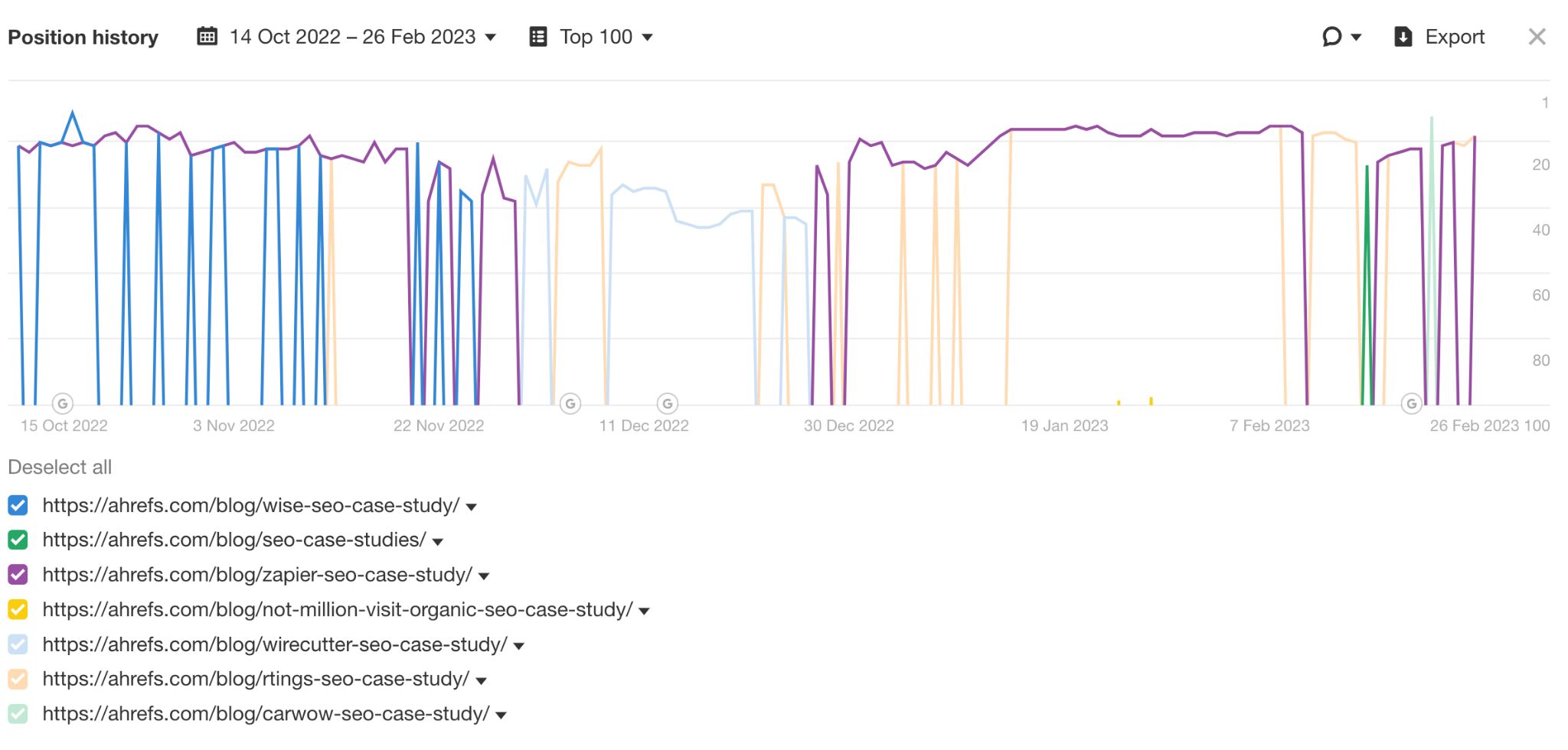

This meant that whenever we published a new case study, the old one was dropped from the SERPs and substituted with the new one.
We fixed the issue by creating a bare-bones pillar page with internal links to all of our case studies. Google ranked the pillar page as the main result with a selection of case studies as site links.
As a result of consolidating, we rank better with one page than we ever did with several. We almost instantly ranked in the top 10 and have remained in the top 3, most of the time giving way only to Google’s page on the same topic. Some of the case studies even ranked as site links to the pillar page.


Example: “broken link building”
For this keyword, we used to have two guides. As you can see below, these rankings didn’t swap, they ranked simultaneously in the top 10 for a long time.


However, we managed to improve that result with a new guide that consolidated information from the old guides — this is the long pink line you can see in the chart below.


So, this was a case of cannibalization because these pages were close enough in terms of content. In such cases, consolidating content can bring better results.
Keyword diversification: good multiple rankings
Keyword diversification is when two or more pages rank for the same keyword simultaneously, and there is likely no benefit in consolidating.
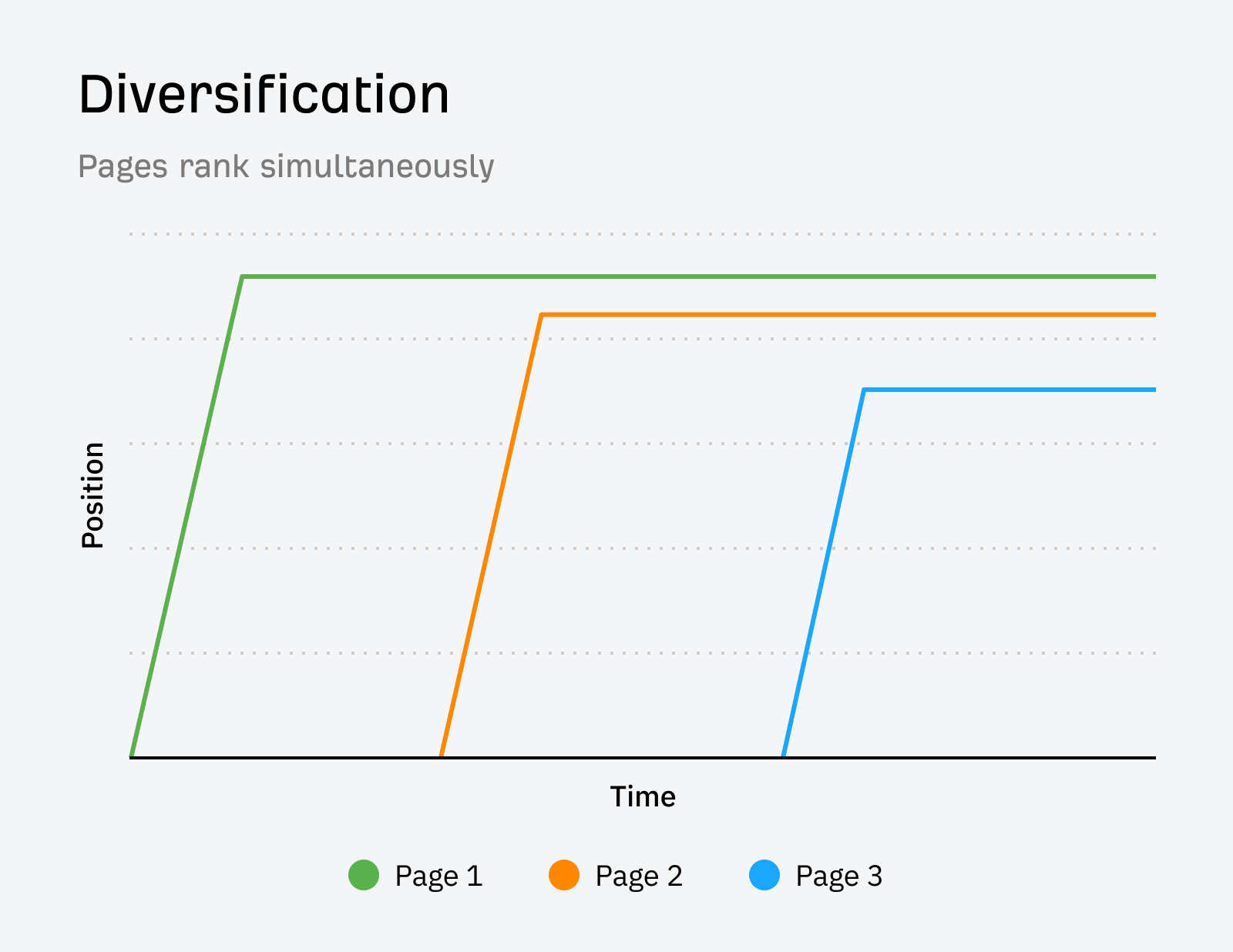

There’s nothing to be fixed here. If Google ranked your site more than once, the system rewarded your content.
Example: “keyword rankings”
For this keyword, we rank with:
- A glossary article ranking in the featured snippet.
- A landing page for a tool at #4 .
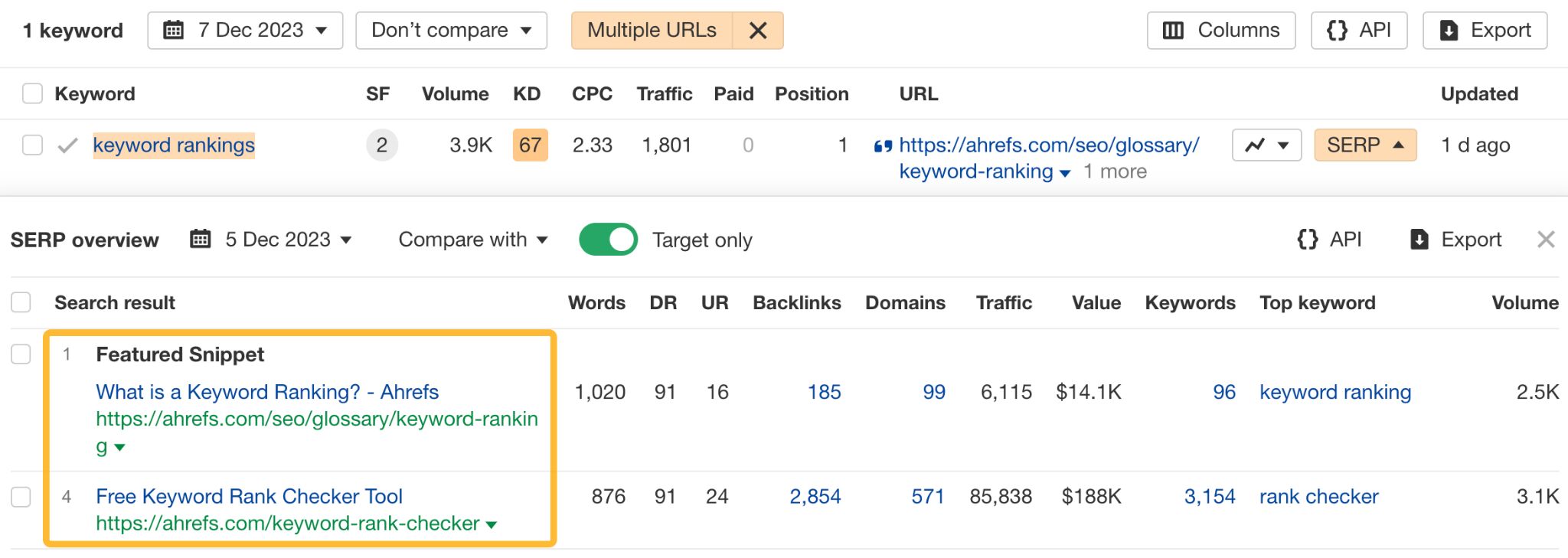

Do the pages swap rankings? No, they’ve been ranking simultaneously for over half a year.


Is there any benefit to consolidating? Unlikely. This way, we serve two kinds of intent: we cater to people who want to get a definition of the term as well as those who want to check their keyword rankings.
Example: “SEO audit”
For this keyword, we rank with:
- A blog article at #4.
- A landing page for a tool at #7.


None of the pages swap rankings.
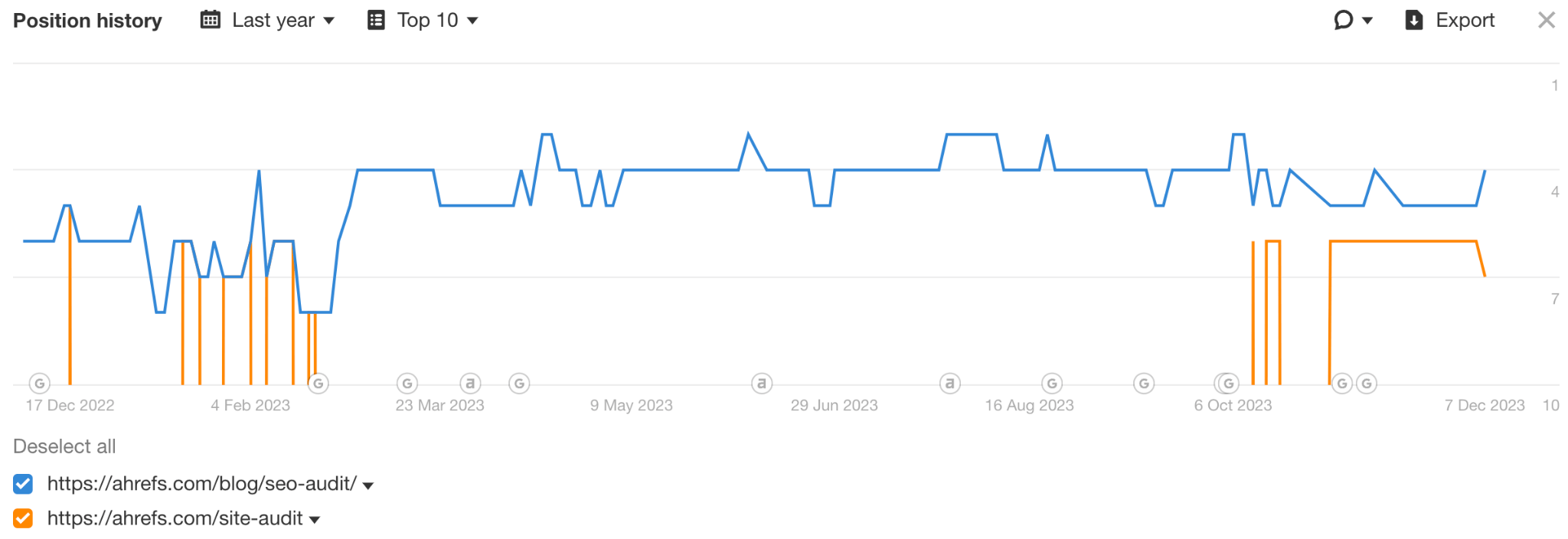

Consolidating them would make no sense because we would need to choose between catering to searchers who want a tool and those who want a guide.
Why rank once when you can rank twice, right?
Sure, if you rank two times in the top 10, you get traffic from both positions (as shown in traffic uplift in the table below). This may seem like an absolute gain in traffic, but it’s a bit tricky. In practice, the new traffic may not be worth it, and you’re also risking pushing down another valuable page.
Let me illustrate this. I took a bunch of keywords where we ranked with 2 URLs in the top ten (otherwise, we’d hardly get any traffic) and looked at the click distribution.
- Traffic uplift — the traffic we gained via ranking another page in top 10 (traffic to new page/traffic to old page).
- Traffic share of the old page — traffic share of the page that ranked first for the keyword.
- Traffic share of the new page — traffic share of the page that came later, i.e., the page that created diversification.
| Keyword | Traffic uplift | Traffic share of the old page | Traffic share of the new page |
|---|---|---|---|
| keyword search | 1.94% | 98.10% | 1.90% |
| seo audit | 37.74% | 72.60% | 27.40% |
| free seo tools | 296.13% | 25.24% | 74.76% |
| affiliate marketing for beginners | 6.63% | 93.78% | 6.22% |
| free keyword research tool | 677.69% | 12.86% | 87.14% |
| keyword rankings | 60.71% | 62.22% | 37.78% |
| how to become an affiliate marketer | 2.39% | 97.67% | 2.33% |
| keyword difficulty | 9233.33% | 1.07% | 98.93% |
As you can see, pages that come later to the SERPs do not always get a bigger traffic share. Just by looking at this small sample, we can see that there are at least three possible scenarios:
- The new page can outrank the old page, either by jumping into a higher position than the original page or pushing the old page lower. More traffic will go to the new page, and in some cases (because that also depends on the CTR), you will gain significantly more traffic.
- The new page will outrank the old, but will get lower CTR, and less traffic. This is what happened in the case of “keyword rankings” — the featured snippet with a definition of a term ranked higher than a landing page with the free tool but got fewer clicks.
- The new page won’t outrank the old page or will rank in site links. Then your diversification efforts will add a few percent of new traffic at best.
Keep in mind that:
- All newly added pages ranked for their unique set of keywords, bringing in additional traffic not listed above.
- We’re only talking about the quantity of traffic here. How qualified that traffic was is a different story.
First off, it’s not something you can fully control. In our case, most of those instances were accidents — Google’s hard-coded propensity to rank some sites multiple times on the same SERP.
But let’s say you see this great opportunity to rank twice in the top 10. It’s definitely possible, but again, a bit tricky. Based on my observations:
- The disparity in clicks between two ranking pages can be significant. Oftentimes, introducing a second page might result in only a marginal increase in traffic while potentially reducing clicks on the originally ranking page.
- It’s more challenging than the good ol’ one-keyword-one-page tactic because the odds are against you since the site diversity update.
- You may need more expensive types of content than what you already have ranking. For instance, a free tool that serves the intent better than an article that already ranks.
- Maintaining top organic rankings for two pages is more difficult than sustaining a single high-ranking spot. In the case of ahrefs.com, situations where a second page maintains a long stable position in the top 10 are rare (see image below).


Most looked like this or worse — ranking and then dropping for months only to reappear for some reason.


Another thing you might try is to double dip in a keyword by ranking videos for keywords with video SERP features or create a hub of definition pages (like our glossary) to rank for featured snippets that require a definition.
But there’s a hack for diversification, too: buy or launch another website.
Google may claim that they are very cautious about ranking the same site twice, but that does not seem to apply to the same business.
To illustrate, when our competitor acquired a popular SEO blog, Google didn’t care about the connection. It has been treating them as two different sites despite being the same business. As a result of diversification, that play allowed them to “double dip” on 8700 keywords ranking in the top 10.
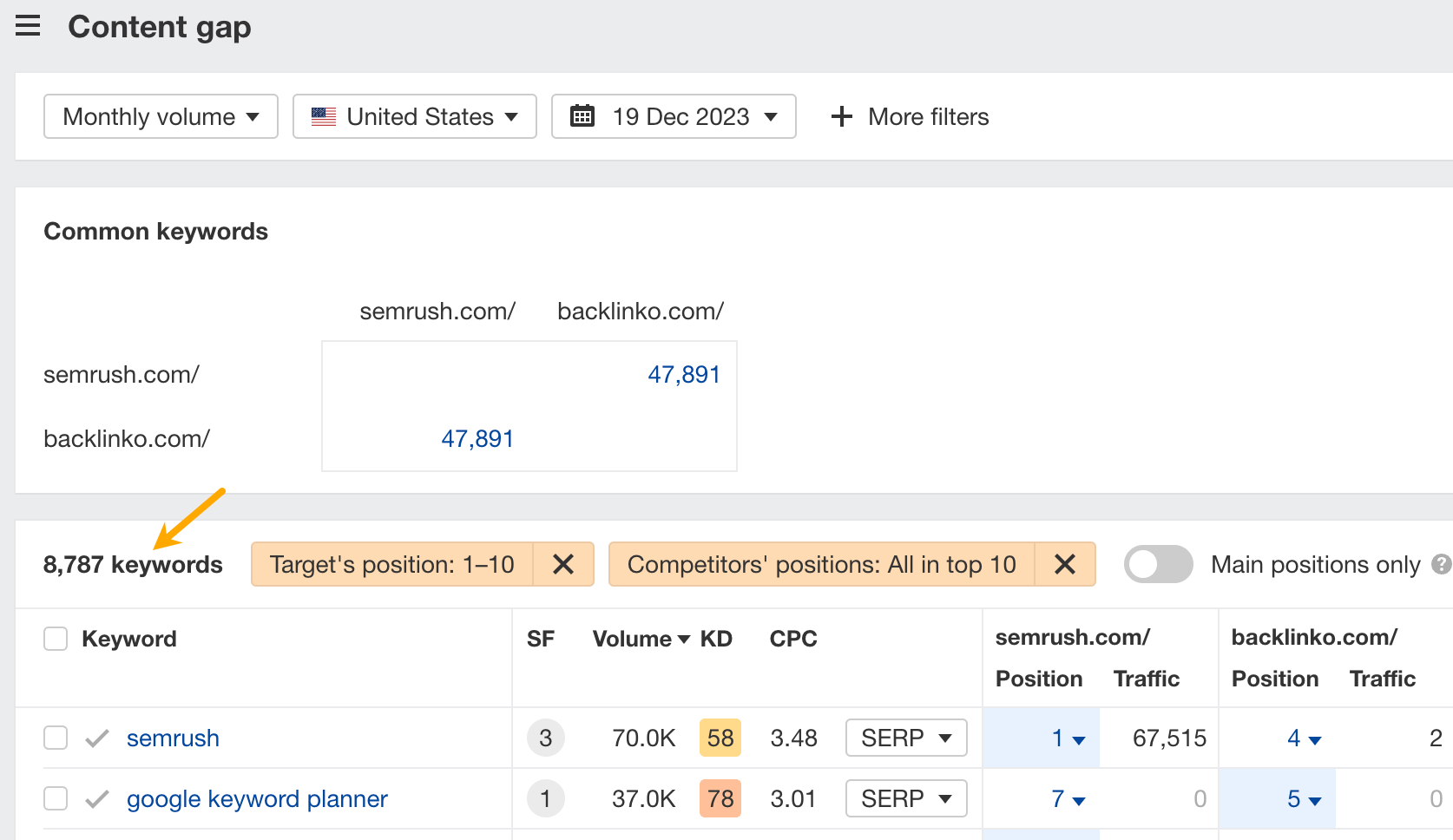

Naturally, they’re not the only example. Glen Allsopp does a fantastic job at following the works of media giants who diversified so well that they literally dominated the SERPs within their niches.
Obviously, more popular keywords will have enough volume to distribute considerable traffic across the top 10. However, that traffic will largely depend on the CTRs, and these are different for each keyword.
If you’re using Ahrefs, open the Traffic share by page report in Keywords Explorer and you’ll get an estimation of how much traffic you can get from each position in the SERPs.
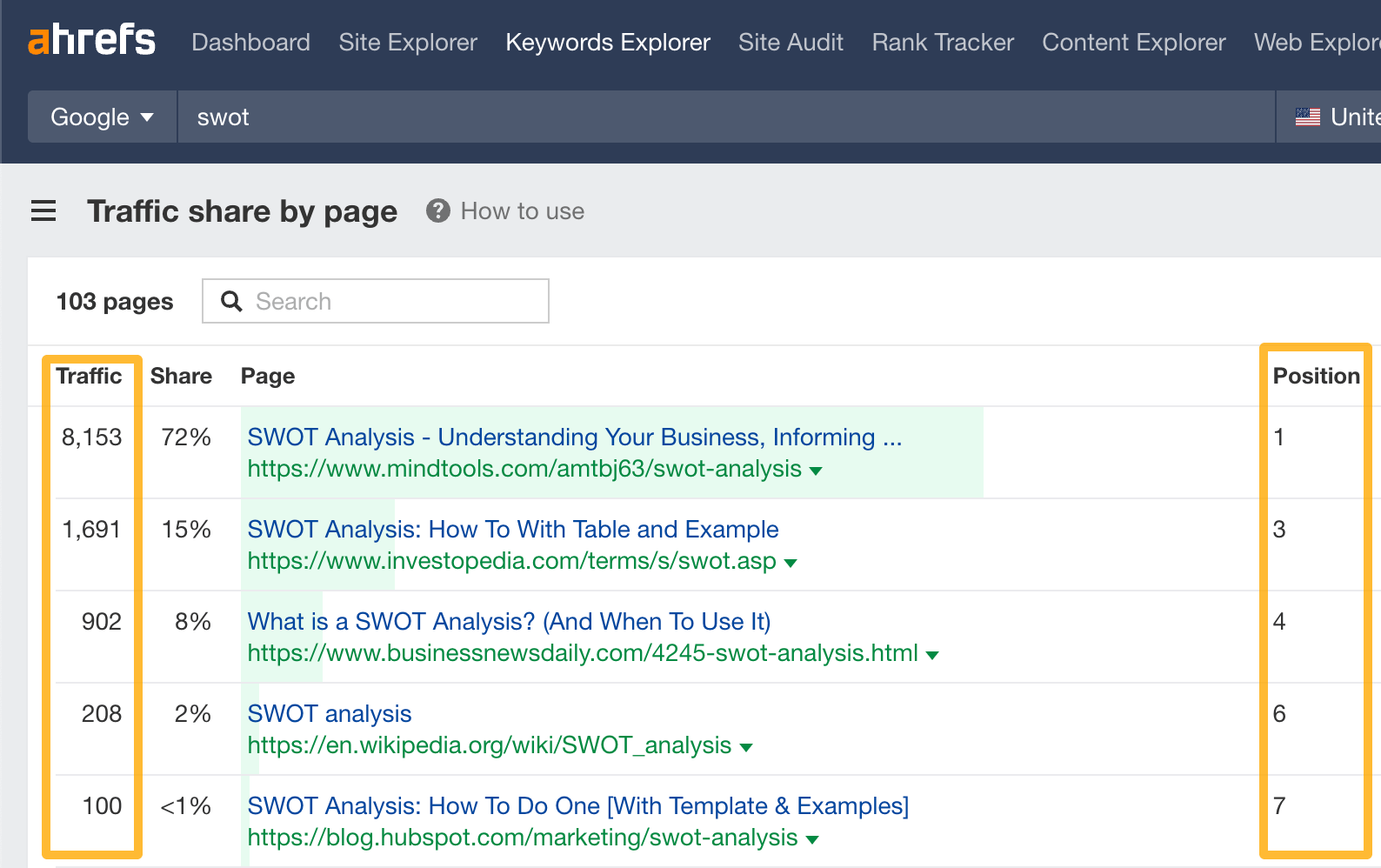

This should give you a good idea of whether taking another position is worth the fight.
Going further, I checked if the metrics and characteristics below had any relation to keyword diversification.
No keyword is too popular for diversification
The median search volume for cannibalized keywords is virtually the same as for our single rankings (50 vs. 40), so we can infer that search volume doesn’t play a determining role.
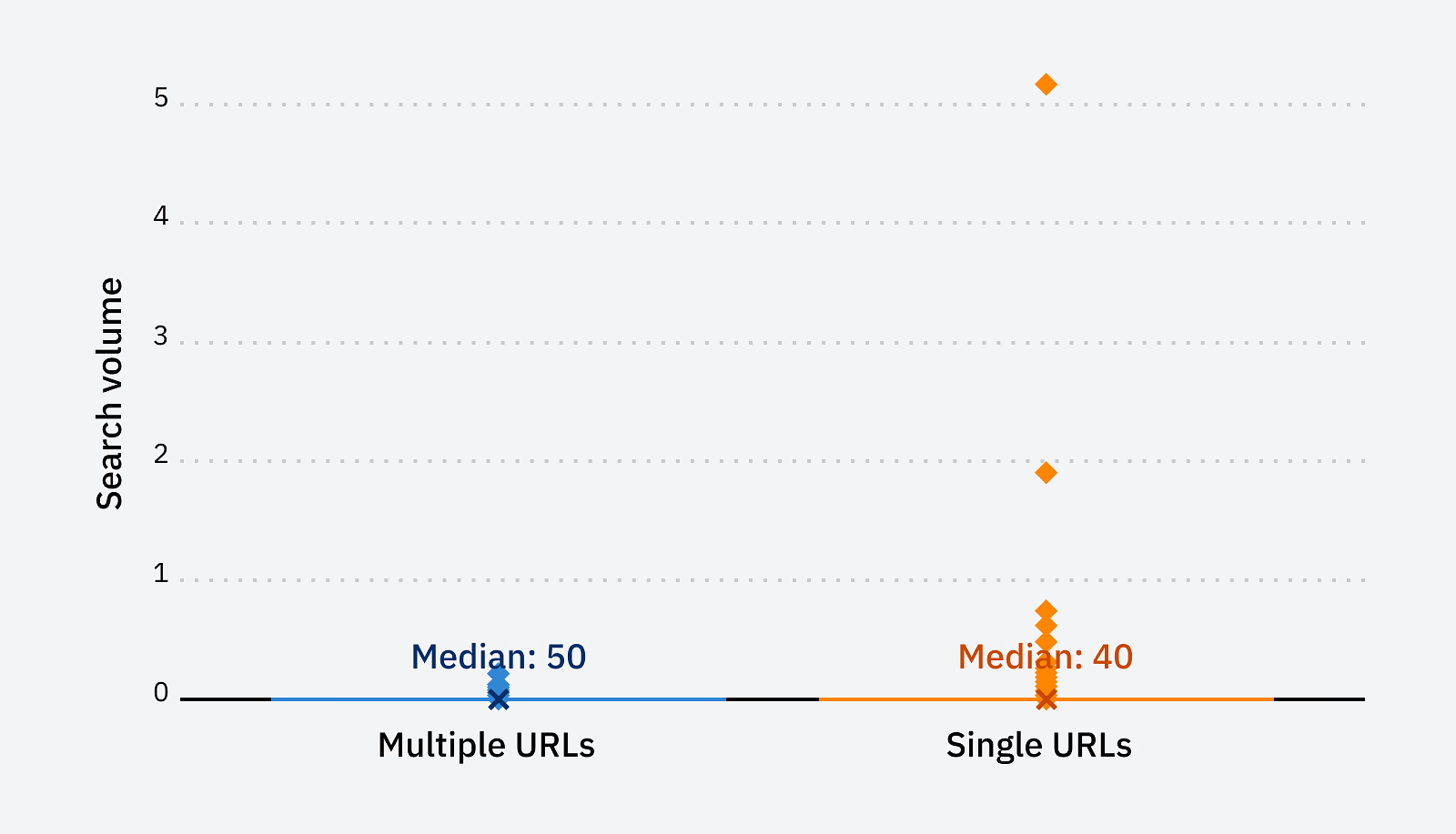

Diversify but make sure to align with search intent
Theoretically, you could rank multiple pages either by aligning with search intents already present on the SERPs or creating something unique but extremely valuable.
If I had to answer this question having only our data, I’d say “follow the crowd”. As you will see in a bit, multiple rankings can happen both with keywords with a single dominant search intent as well as those with a more mixed intent but none of our pages broke outside of already existing types and formats of content.
To illustrate my point, here’s a breakdown of the same top 10 keywords you saw earlier, but this time with a search intent analysis (using our 3C’s framework). In all cases, our ranking content aligns with the existing content types:
| Keyword | Content types in top 10 | Content format (if article) in top 10 | Our ranking content (on Dec 5, 2023) |
|---|---|---|---|
| keyword search | Landing pages (free and premium tools) | – | #8, #10 (both free tools) |
| seo audit | 7 articles, 2 landing pages, | Guides | #5 (guide), #6 (landing page premium tool) |
| free seo tools | 7 articles, 2 landing pages (free tools) | Listicles | #4 (listicle), #7 (free tools landing page) |
| affiliate marketing for beginners | 9 blog posts | Guides | #3 with 3 site links (all guides) |
| free keyword research tool | 8 landing pages, 2 articles | Listicles | #2 (listicle), #4 (free tool) |
| keyword rankings | 7 articles, 2 landing pages (free tools) | 5 guides, 1 definition post, 1 listicle | #1 (article), #4 (free tool) |
| how to become an affiliate marketer | Articles | Guides | #3 with 3 site links (all guides) |
| keyword difficulty | 5 articles, 2 forum posts, 2 landing pages (free and premium tools) | Guides | #1 (free tool), #5 (guide) |
So when there are only article ranking, your best chances might be by diversifying with articles. And if you see different types of pages ranking, say an article and a landing page, there’s a chance of ranking by creating both these types.
Tip
If you’re an Ahrefs user, there’s a nifty AI feature in Keywords Explorer and Site Explorer that estimates the traffic share to each type of intent in the top 10. Check it out.


You don’t need less specific keywords to diversify
We’d expect long-tail keywords to have fewer multiple ranking instances (be it cannibalization or diversification) because the intent would be more defined from the query.
To measure this, I compared word count distribution in keywords with single rankings and multiple rankings using boxplots.


As you can see, the boxplots are almost identical, so no correlation could be at play here.
However, an interesting takeaway here is that if we look at a histogram of word count frequency in the multiple URL data set, we see that most keywords occupied the 3–4 word count range. That indicates ranking multiple times for quite specific search queries is definitely possible.
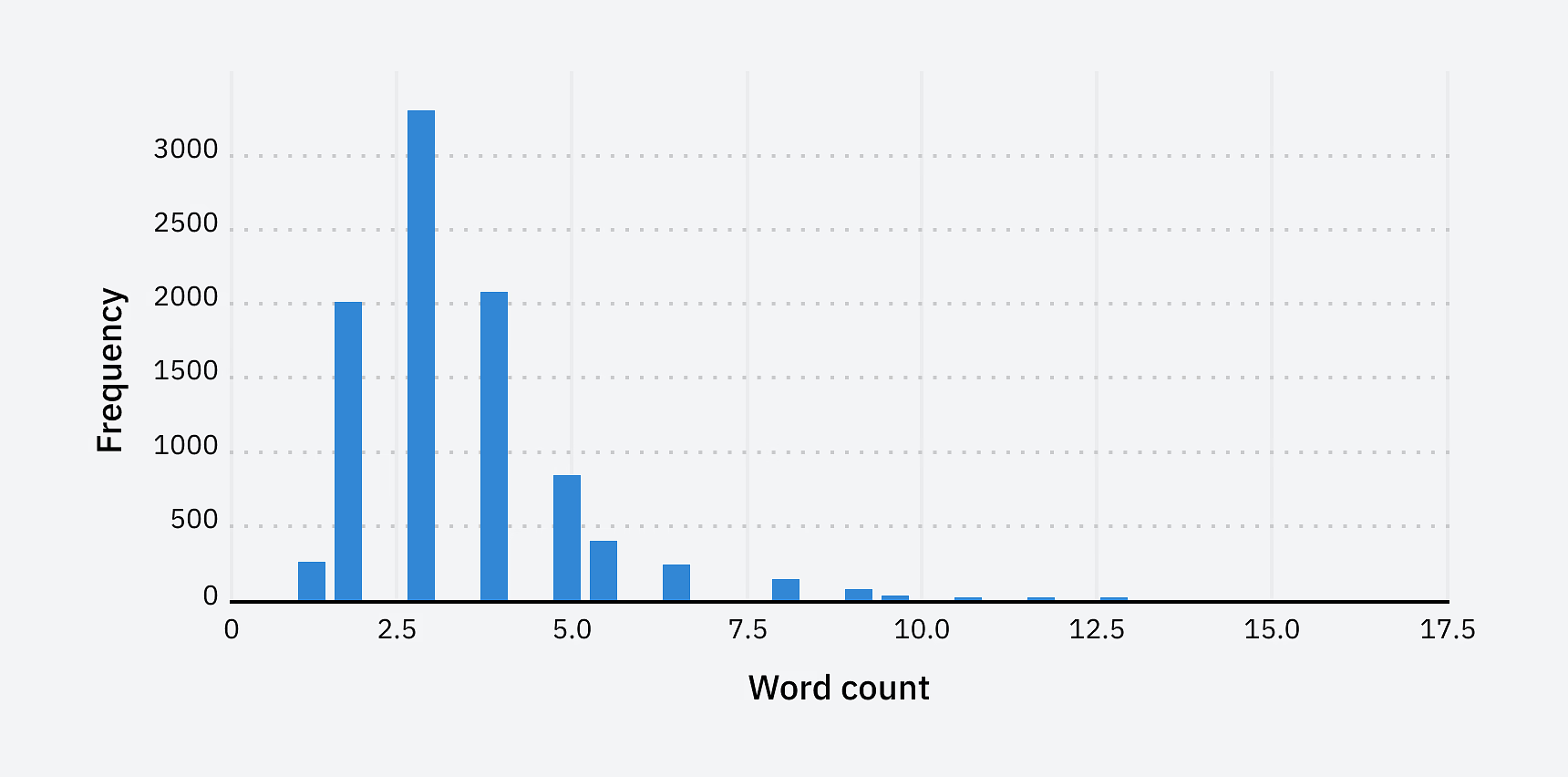

Surprisingly, multiple rankings were more common for high KD keywords
I also wanted to see if it would be harder to get multiple rankings for keywords with high KD value (Ahrefs metric), i.e., keywords with SERPs dominated by pages with a strong backlink profile.
Again, I compared multiple rankings with single rankings.


Here, we can see a clear difference. The median of multiple rankings is way higher than single rankings (64 vs. 37).
One thing is for sure with such a result—you can rank multiple times, even for highly competitive keywords.
Final thoughts
Let’s sum up.
Multiple rankings in Google create two effects: cannibalization and diversification.
This means that classic SEO theory is wrong—you don’t need to go and fix each keyword with multiple rankings.
This also means that you can potentially take advantage of Google’s propensity for multiple rankings and can get more traffic out of a keyword. That said, I’d consider it a pro move, which may have a high opportunity cost compared to targeting some other keyword with just one page. That’s because:
- The additional rankings may not last long.
- You may “outrank yourself”, and the page you outrank will get fewer clicks.
- You may need more expensive types of content than what you already have. For instance, a free tool that serves the intent better than an article that already ranks.
Thanks for reading! If you have any questions or comments, find me on X or LinkedIn.
SEO
Google Further Postpones Third-Party Cookie Deprecation In Chrome

Google has again delayed its plan to phase out third-party cookies in the Chrome web browser. The latest postponement comes after ongoing challenges in reconciling feedback from industry stakeholders and regulators.
The announcement was made in Google and the UK’s Competition and Markets Authority (CMA) joint quarterly report on the Privacy Sandbox initiative, scheduled for release on April 26.
Chrome’s Third-Party Cookie Phaseout Pushed To 2025
Google states it “will not complete third-party cookie deprecation during the second half of Q4” this year as planned.
Instead, the tech giant aims to begin deprecating third-party cookies in Chrome “starting early next year,” assuming an agreement can be reached with the CMA and the UK’s Information Commissioner’s Office (ICO).
The statement reads:
“We recognize that there are ongoing challenges related to reconciling divergent feedback from the industry, regulators and developers, and will continue to engage closely with the entire ecosystem. It’s also critical that the CMA has sufficient time to review all evidence, including results from industry tests, which the CMA has asked market participants to provide by the end of June.”
Continued Engagement With Regulators
Google reiterated its commitment to “engaging closely with the CMA and ICO” throughout the process and hopes to conclude discussions this year.
This marks the third delay to Google’s plan to deprecate third-party cookies, initially aiming for a Q3 2023 phaseout before pushing it back to late 2024.
The postponements reflect the challenges in transitioning away from cross-site user tracking while balancing privacy and advertiser interests.
Transition Period & Impact
In January, Chrome began restricting third-party cookie access for 1% of users globally. This percentage was expected to gradually increase until 100% of users were covered by Q3 2024.
However, the latest delay gives websites and services more time to migrate away from third-party cookie dependencies through Google’s limited “deprecation trials” program.
The trials offer temporary cookie access extensions until December 27, 2024, for non-advertising use cases that can demonstrate direct user impact and functional breakage.
While easing the transition, the trials have strict eligibility rules. Advertising-related services are ineligible, and origins matching known ad-related domains are rejected.
Google states the program aims to address functional issues rather than relieve general data collection inconveniences.
Publisher & Advertiser Implications
The repeated delays highlight the potential disruption for digital publishers and advertisers relying on third-party cookie tracking.
Industry groups have raised concerns that restricting cross-site tracking could push websites toward more opaque privacy-invasive practices.
However, privacy advocates view the phaseout as crucial in preventing covert user profiling across the web.
With the latest postponement, all parties have more time to prepare for the eventual loss of third-party cookies and adopt Google’s proposed Privacy Sandbox APIs as replacements.
Featured Image: Novikov Aleksey/Shutterstock
SEO
How To Write ChatGPT Prompts To Get The Best Results

ChatGPT is a game changer in the field of SEO. This powerful language model can generate human-like content, making it an invaluable tool for SEO professionals.
However, the prompts you provide largely determine the quality of the output.
To unlock the full potential of ChatGPT and create content that resonates with your audience and search engines, writing effective prompts is crucial.
In this comprehensive guide, we’ll explore the art of writing prompts for ChatGPT, covering everything from basic techniques to advanced strategies for layering prompts and generating high-quality, SEO-friendly content.
Writing Prompts For ChatGPT
What Is A ChatGPT Prompt?
A ChatGPT prompt is an instruction or discussion topic a user provides for the ChatGPT AI model to respond to.
The prompt can be a question, statement, or any other stimulus to spark creativity, reflection, or engagement.
Users can use the prompt to generate ideas, share their thoughts, or start a conversation.
ChatGPT prompts are designed to be open-ended and can be customized based on the user’s preferences and interests.
How To Write Prompts For ChatGPT
Start by giving ChatGPT a writing prompt, such as, “Write a short story about a person who discovers they have a superpower.”
ChatGPT will then generate a response based on your prompt. Depending on the prompt’s complexity and the level of detail you requested, the answer may be a few sentences or several paragraphs long.
Use the ChatGPT-generated response as a starting point for your writing. You can take the ideas and concepts presented in the answer and expand upon them, adding your own unique spin to the story.
If you want to generate additional ideas, try asking ChatGPT follow-up questions related to your original prompt.
For example, you could ask, “What challenges might the person face in exploring their newfound superpower?” Or, “How might the person’s relationships with others be affected by their superpower?”
Remember that ChatGPT’s answers are generated by artificial intelligence and may not always be perfect or exactly what you want.
However, they can still be a great source of inspiration and help you start writing.
Must-Have GPTs Assistant
I recommend installing the WebBrowser Assistant created by the OpenAI Team. This tool allows you to add relevant Bing results to your ChatGPT prompts.
This assistant adds the first web results to your ChatGPT prompts for more accurate and up-to-date conversations.
It is very easy to install in only two clicks. (Click on Start Chat.)
For example, if I ask, “Who is Vincent Terrasi?,” ChatGPT has no answer.
With WebBrower Assistant, the assistant creates a new prompt with the first Bing results, and now ChatGPT knows who Vincent Terrasi is.
 Screenshot from ChatGPT, March 2023
Screenshot from ChatGPT, March 2023You can test other GPT assistants available in the GPTs search engine if you want to use Google results.
Master Reverse Prompt Engineering
ChatGPT can be an excellent tool for reverse engineering prompts because it generates natural and engaging responses to any given input.
By analyzing the prompts generated by ChatGPT, it is possible to gain insight into the model’s underlying thought processes and decision-making strategies.
One key benefit of using ChatGPT to reverse engineer prompts is that the model is highly transparent in its decision-making.
This means that the reasoning and logic behind each response can be traced, making it easier to understand how the model arrives at its conclusions.
Once you’ve done this a few times for different types of content, you’ll gain insight into crafting more effective prompts.
Prepare Your ChatGPT For Generating Prompts
First, activate the reverse prompt engineering.
- Type the following prompt: “Enable Reverse Prompt Engineering? By Reverse Prompt Engineering I mean creating a prompt from a given text.”
 Screenshot from ChatGPT, March 2023
Screenshot from ChatGPT, March 2023ChatGPT is now ready to generate your prompt. You can test the product description in a new chatbot session and evaluate the generated prompt.
- Type: “Create a very technical reverse prompt engineering template for a product description about iPhone 11.”
 Screenshot from ChatGPT, March 2023
Screenshot from ChatGPT, March 2023The result is amazing. You can test with a full text that you want to reproduce. Here is an example of a prompt for selling a Kindle on Amazon.
- Type: “Reverse Prompt engineer the following {product), capture the writing style and the length of the text :
product =”
 Screenshot from ChatGPT, March 2023
Screenshot from ChatGPT, March 2023I tested it on an SEJ blog post. Enjoy the analysis – it is excellent.
- Type: “Reverse Prompt engineer the following {text}, capture the tone and writing style of the {text} to include in the prompt :
text = all text coming from https://www.searchenginejournal.com/google-bard-training-data/478941/”
 Screenshot from ChatGPT, March 2023
Screenshot from ChatGPT, March 2023But be careful not to use ChatGPT to generate your texts. It is just a personal assistant.
Go Deeper
Prompts and examples for SEO:
- Keyword research and content ideas prompt: “Provide a list of 20 long-tail keyword ideas related to ‘local SEO strategies’ along with brief content topic descriptions for each keyword.”
- Optimizing content for featured snippets prompt: “Write a 40-50 word paragraph optimized for the query ‘what is the featured snippet in Google search’ that could potentially earn the featured snippet.”
- Creating meta descriptions prompt: “Draft a compelling meta description for the following blog post title: ’10 Technical SEO Factors You Can’t Ignore in 2024′.”
Important Considerations:
- Always Fact-Check: While ChatGPT can be a helpful tool, it’s crucial to remember that it may generate inaccurate or fabricated information. Always verify any facts, statistics, or quotes generated by ChatGPT before incorporating them into your content.
- Maintain Control and Creativity: Use ChatGPT as a tool to assist your writing, not replace it. Don’t rely on it to do your thinking or create content from scratch. Your unique perspective and creativity are essential for producing high-quality, engaging content.
- Iteration is Key: Refine and revise the outputs generated by ChatGPT to ensure they align with your voice, style, and intended message.
Additional Prompts for Rewording and SEO:
– Rewrite this sentence to be more concise and impactful.
– Suggest alternative phrasing for this section to improve clarity.
– Identify opportunities to incorporate relevant internal and external links.
– Analyze the keyword density and suggest improvements for better SEO.
Remember, while ChatGPT can be a valuable tool, it’s essential to use it responsibly and maintain control over your content creation process.
Experiment And Refine Your Prompting Techniques
Writing effective prompts for ChatGPT is an essential skill for any SEO professional who wants to harness the power of AI-generated content.
Hopefully, the insights and examples shared in this article can inspire you and help guide you to crafting stronger prompts that yield high-quality content.
Remember to experiment with layering prompts, iterating on the output, and continually refining your prompting techniques.
This will help you stay ahead of the curve in the ever-changing world of SEO.
More resources:
Featured Image: Tapati Rinchumrus/Shutterstock
SEO
Measuring Content Impact Across The Customer Journey

Understanding the impact of your content at every touchpoint of the customer journey is essential – but that’s easier said than done. From attracting potential leads to nurturing them into loyal customers, there are many touchpoints to look into.
So how do you identify and take advantage of these opportunities for growth?
Watch this on-demand webinar and learn a comprehensive approach for measuring the value of your content initiatives, so you can optimize resource allocation for maximum impact.
You’ll learn:
- Fresh methods for measuring your content’s impact.
- Fascinating insights using first-touch attribution, and how it differs from the usual last-touch perspective.
- Ways to persuade decision-makers to invest in more content by showcasing its value convincingly.
With Bill Franklin and Oliver Tani of DAC Group, we unravel the nuances of attribution modeling, emphasizing the significance of layering first-touch and last-touch attribution within your measurement strategy.
Check out these insights to help you craft compelling content tailored to each stage, using an approach rooted in first-hand experience to ensure your content resonates.
Whether you’re a seasoned marketer or new to content measurement, this webinar promises valuable insights and actionable tactics to elevate your SEO game and optimize your content initiatives for success.
View the slides below or check out the full webinar for all the details.
-

 PPC6 days ago
PPC6 days ago19 Best SEO Tools in 2024 (For Every Use Case)
-
SEARCHENGINES5 days ago
Daily Search Forum Recap: April 19, 2024
-

 MARKETING7 days ago
MARKETING7 days agoEcommerce evolution: Blurring the lines between B2B and B2C
-
SEARCHENGINES6 days ago
Daily Search Forum Recap: April 18, 2024
-

 WORDPRESS6 days ago
WORDPRESS6 days agoHow to Make $5000 of Passive Income Every Month in WordPress
-

 SEO7 days ago
SEO7 days ago2024 WordPress Vulnerability Report Shows Errors Sites Keep Making
-

 WORDPRESS6 days ago
WORDPRESS6 days ago10 Amazing WordPress Design Resouces – WordPress.com News
-
WORDPRESS7 days ago
[GET] The7 Website And Ecommerce Builder For WordPress















